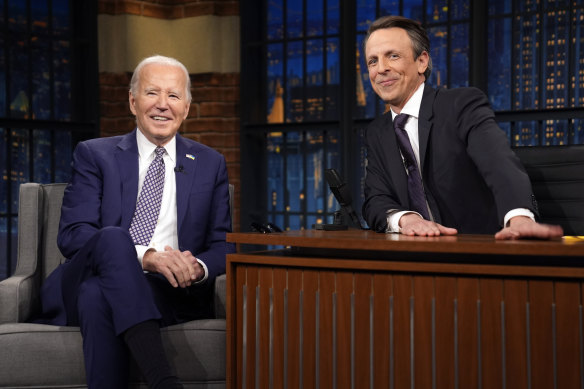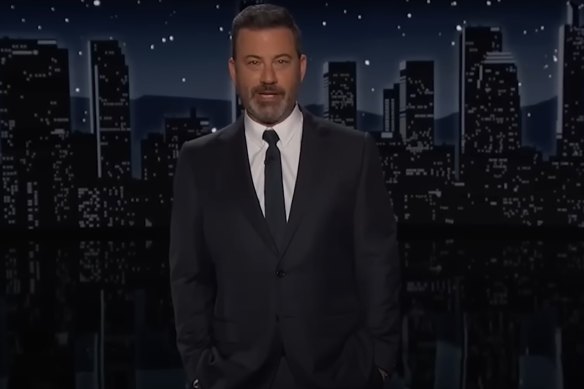This was published 8 months ago
It’s so funny how we don’t talk any more. What’s up with late night TV?
By Nell Geraets
Over the past few months, late-night talk show hosts have been doing what they do best: talk. However, beyond the political jokes and banter with celebrity guests, they’ve been discussing the possible death of the format itself.
“If I were a 25-year-old whose dream was to host a late-night show, I would have some concerns,” Late Night host Seth Meyers told The Town podcast last week. “But at the same time … They’re not watching Late Night, so they’re probably not dreaming about doing it.”

For a long time, shows like Late Night with Seth Meyers were the pinnacle of network television, featuring the biggest celebrities and even presidents. Now, their future is uncertain.Credit: AP
Similarly, Jimmy Kimmel, host of Jimmy Kimmel Live!, told the Politickin’ podcast in August he didn’t know if there would be late-night talk shows on US network television in 10 years.
This sentiment has intensified over the past year with the cancellation of The Late Late Show With James Corden and The Tonight Show Starring Jimmy Fallon shrinking from five nights a week to four.
The landscape in which late-night talk shows operate has become much more saturated since the days of Johnny Carson and David Letterman, says Hussein Kobeissi, a University of Sydney PhD candidate who researches US late-night television.

Talk show host Jimmy Kimmel thinks US late-night talk shows may be dying.Credit: Screenshot/Jimmy Kimmel Live
“In the past, Americans had a handful of these shows to choose from … However, with the proliferation of media options over the decades, and the emergence of ever smaller niche audiences, we see large broadcast audiences become more fragmented over a much larger number of late-night shows.”
Today’s shows aren’t just competing with each other, they’re up against other forms of media: streaming, YouTube and TikTok – the latter of which offers reactions to pop-cultural moments and current affairs in real-time. Many of the late-night shows are now broken into digestible clips and uploaded to social media, meaning audiences can watch the most viral parts whenever they want, something linear broadcasts can’t offer.
Ratings seem to reinforce concerns about the format’s health. According to The Hollywood Reporter, The Late Show With Stephen Colbert claimed 3.81 million US viewers in 2018-19. By 2023-24, this number had decreased by 32 per cent (2.6 million viewers).
In Australia, late-night talk shows, though not as plentiful as in the US, were immensely popular in the 1990s and early 2000s.
Graham Kennedy kicked things off in the 50s, first with In Melbourne Tonight, and then The Graham Kennedy Show. In 1990, Network Seven’s Tonight Live with Steve Vizard gained an average viewer share of 42.6 per cent of viewers in all Australian households (viewer share is the audience for total TV at a particular time), according to Nielsen. Vizard won a Gold Logie for the show in 1991. Rove, which starred Rove McManus and ran between 1999 and 2009, won five Logies, and claimed more than a million viewers for certain episodes.
“These shows were massively successful for the networks,” says Vizard. “Our show made them a lot of money … And they were some of the most inexpensive shows to make. They were literally in a studio with some chairs and people chatting. They eventually had a band, but even they were super cheap.”
However, after Rove wrapped in 2009, Australian late-night talk shows all-but disappeared. Dr Liz Giuffre, a senior lecturer in communication, music and sound design at UTS, says some broadcasters have attempted to revive the genre, such as the ABC with Tonightly with Tom Ballard in 2017. However, this show didn’t even last a year on-air. Ballard was unavailable for comment.
“The issue here is population and money. These shows are the market for big international celebrities. Do we have enough people to come over and do that?” Giuffre says. “Repeats of the American shows are also usually being played in those night time-slots, so that real-estate is already being spent on an international product.”
The definition of a late-night talk show is more ambiguous in Australia, Giuffre notes. She argues shows like The Project offer the same entertainment as, say, Jimmy Kimmel Live!, only earlier. Some former Australian late-night shows, which mirrored the US versions more closely, did not air every night of the week (Rove only aired once a week, and eventually wasn’t even broadcast live).
Australian late-night shows were usually managed by the networks’ news and current affairs departments, Vizard says. This is why most attempted revivals are coupled with a news component.
“Late-night talk shows were never meant to be current affairs shows … The networks are preoccupied with news because they’ve got it in their heads that it’s only news that differentiates them from streaming services. But they’ve got it wrong. What distinguishes them is topicality and surprise.”
Dr Rodney Taveira, who researches US television at the United States Studies Centre, says Australians are increasingly turning to podcasts and live-streamed shows on YouTube instead of watching free-to-air to catch up on culture and entertainment news.
“Even radio is finding a second life fulfilling the previous functions of the late-night talk show, as it adds video of interviews, which then gets clipped and circulated online.”
Ultimately, the Australian experience means little for the future of late-night TV in the US, Taveira notes.
“Australia is just too small of a market to sustain a late-night talk show five times a week, let alone several … The popularity of Last Week Tonight with John Oliver on HBO and Letterman’s show on Netflix show there is life yet in this kind of US television, so long as it’s adaptable,” he says. “So long as these shows are happy to be clipped, and can monetise being clipped, they will enjoy viewership beyond television.”
Find out the next TV, streaming series and movies to add to your must-sees. Get The Watchlist delivered every Thursday.